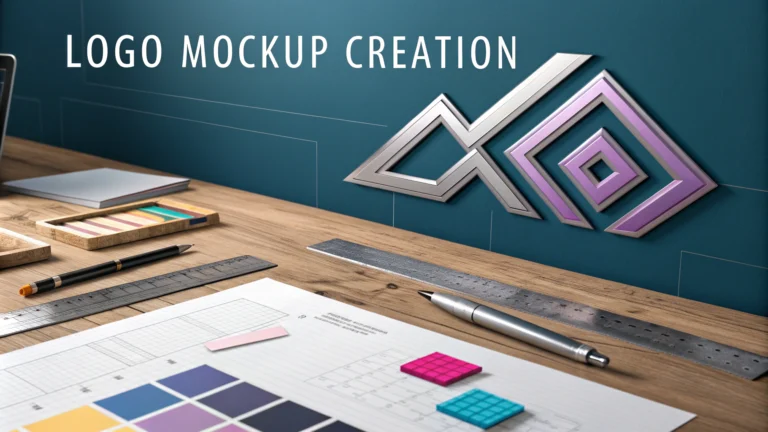Creating professional logo mockups helps designers showcase their work and win client approval.
A logo mockup places your design onto realistic surfaces or products to demonstrate how it will appear in real-world applications.
Essential Tools for Logo Mockup Creation
- Adobe Photoshop
- Adobe Illustrator
- Mockup Generator Tools (like Smartmockups or PlaceIt)
- High-quality mockup templates
Step-by-Step Mockup Creation Process
- Prepare Your Logo File
- Save as PNG with transparent background
- Create versions in both color and monochrome
- Maintain high resolution (minimum 300 DPI)
- Choose Appropriate Mockup Templates
- Business cards
- Signage
- Merchandise
- Digital displays
Free Mockup Resources
- Freepik – Various free templates
- Mockup World – High-quality free mockups
- GraphicBurger – Professional-grade mockups
Tips for Professional Results
- Match lighting and shadows to the base image
- Consider the viewing angle and perspective
- Use smart objects in Photoshop for easy editing
- Present multiple mockup variations
Testing your logo mockup on different backgrounds ensures versatility and broad application potential.
Common Mockup Mistakes to Avoid
- Using low-resolution images
- Incorrect scaling or proportions
- Unrealistic lighting effects
- Poor template selection
| Surface Type | Recommended File Format |
|---|---|
| Paper/Print | CMYK PDF/PNG |
| Digital Screens | RGB PNG/SVG |
| Merchandise | Vector AI/EPS |
Regular practice with different mockup styles and techniques will improve your presentation skills and client satisfaction rates.
Advanced Mockup Techniques
- Custom perspective adjustments
- Material-specific reflections and textures
- Environmental lighting integration
- Multi-surface presentations
Client Presentation Strategies
Digital Presentation
- Interactive PDF portfolios
- Online mockup galleries
- Video presentations of animated mockups
- Side-by-side comparisons
Physical Presentation
- Printed mockup boards
- Sample products
- Material swatches
- Scale demonstrations
Quality Control Checklist
- Verify color accuracy across all formats
- Check resolution on various screen sizes
- Test printing quality on different materials
- Review scaling consistency
Future-Proofing Your Mockups
- Maintain organized source files
- Create responsive versions for digital platforms
- Archive high-resolution originals
- Document mockup specifications
Conclusion
Professional logo mockups are essential for effective brand presentation and client communication. Success depends on combining technical expertise with creative vision, while maintaining attention to detail throughout the process. Regular updates to your mockup techniques and tools will ensure continued professional growth and client satisfaction.
Remember to maintain a diverse mockup portfolio and stay current with industry trends to deliver the highest quality presentations for every project.
FAQs
1. What’s the difference between a logo mockup and a logo design?
A logo mockup shows how your finished logo will look in real-world applications like business cards, signage, or merchandise, while logo design is the actual process of creating the logo itself.
2. What file formats do I need for my logo mockup presentations?
You typically need high-resolution files in both vector (AI, EPS, SVG) and raster (PSD, PNG, JPEG) formats to create professional logo mockups.
3. What are the essential elements of an effective logo mockup?
Essential elements include proper lighting and shadows, realistic texture mapping, correct perspective angles, appropriate scaling, and environmental context that matches the brand’s identity.
4. How long should the logo mockup creation process take?
A professional logo mockup typically takes 1-4 hours per application scenario, depending on complexity and the number of different presentations required.
5. What software is commonly used for creating logo mockups?
Adobe Photoshop is the industry standard, but designers also use Adobe Dimension, Mockup Plus, and Smart Object templates for logo mockup creation.
6. How many mockup variations should be presented to a client?
Generally, 3-5 different mockup applications are recommended to demonstrate logo versatility across various mediums and contexts.
7. What are the most important mockup scenarios to show clients?
Essential mockup scenarios include business stationery, signage, digital applications (website/social media), merchandise, and vehicle branding if applicable to the business.
8. What resolution should logo mockups be created in?
Logo mockups should be created at a minimum of 300 DPI for print applications and 72 DPI for digital presentations, with dimensions appropriate for their intended use.
9. How do I ensure color accuracy in logo mockups?
Use color profiles appropriate for the output medium (CMYK for print mockups, RGB for digital), and maintain brand color consistency across all mockup applications.
10. What’s the difference between static and dynamic logo mockups?
Static mockups show the logo in fixed positions, while dynamic mockups demonstrate how the logo moves or adapts in digital environments or animated applications.







